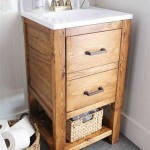What Is The Best Color For A Bathroom Vanity Mirror?
Bathroom vanity mirrors play a crucial role in both the functionality and aesthetics of a bathroom space. While the reflective surface is the primary function, the frame's color significantly impacts the overall design. Selecting the right color can enhance the existing décor, create a focal point, or seamlessly blend into the background. There is no single "best" color, as the ideal choice depends on several factors, including the overall bathroom style, existing color palette, and desired atmosphere.
Neutral colors are a popular choice for bathroom vanity mirrors due to their versatility and timeless appeal. White, arguably the most common choice, offers a clean, crisp look that brightens the space and works well with virtually any design style. It can make a small bathroom appear larger and complements both traditional and contemporary aesthetics. Similarly, black offers a sophisticated and elegant touch, creating a bold statement or a subtle contrast depending on the surrounding colors. Gray, another popular neutral, provides a calming and balanced feel, bridging the gap between white and black and offering various shades to match different design schemes.
Metallic finishes offer a touch of glamour and sophistication to bathroom vanity mirrors. Silver, a classic choice, complements chrome fixtures and adds a bright, reflective element to the space. Gold finishes, particularly brushed gold and brass, have gained popularity in recent years, bringing warmth and a luxurious feel to the bathroom. Copper, with its unique reddish-brown hue, introduces a touch of rustic charm or modern elegance depending on the overall design. Metallic finishes can be incorporated through the frame itself or through accent details.
Wooden frames bring natural warmth and texture to the bathroom. The specific wood type and finish significantly influence the overall look. Light woods like oak and maple create a bright and airy feel, complementing Scandinavian or farmhouse styles. Darker woods like walnut and mahogany add richness and depth, suitable for traditional or more formal bathrooms. Reclaimed wood offers a unique, rustic touch, bringing character and a sense of history to the space. Choosing a wood finish that complements existing cabinetry or flooring can create a cohesive and harmonious design.
Adding a pop of color to the bathroom vanity mirror can create a vibrant and energetic atmosphere. Bold colors like blue, green, or yellow can serve as a focal point and reflect personal style. Consider incorporating colors that complement the existing color scheme, such as accent colors found in tiles or towels. For a more subtle approach, pastel shades can add a touch of softness and personality without overwhelming the space. When opting for bolder colors, it's essential to consider the overall balance and ensure the color complements, rather than clashes with, the rest of the bathroom décor.
Matching the vanity mirror frame to the vanity itself is a common practice that creates a unified and cohesive look. This approach works particularly well in smaller bathrooms, as it visually streamlines the space. Matching finishes, such as a white vanity with a white-framed mirror, create a seamless and clean aesthetic. Alternatively, complementing the vanity's hardware with the mirror frame can tie the elements together while adding a touch of visual interest. For example, a dark wood vanity paired with a mirror featuring dark metal accents can create a balanced and sophisticated look.
The size and shape of the bathroom vanity mirror also influence the color choice. Larger mirrors can handle bolder colors and more intricate designs, while smaller mirrors might benefit from simpler frames and lighter colors. The shape of the mirror can also play a role; a round or oval mirror might look best with a thin metal frame, while a rectangular mirror might suit a wider wooden frame. Consider the proportions of the mirror and the surrounding space when selecting a frame color.
The lighting in the bathroom significantly impacts how the color of the vanity mirror frame appears. Natural light can enhance the true color of the frame, while artificial light can cast a different hue. Consider the type and placement of lighting fixtures when selecting a frame color. Test different colors under the existing lighting conditions to ensure the desired effect is achieved. For example, a warm-toned light might make a cool-colored frame appear dull, while a cool-toned light might make a warm-colored frame appear overly yellow.
Ultimately, the best color for a bathroom vanity mirror is a matter of personal preference and design aesthetics. Consider the factors mentioned above, experiment with different options, and choose a color that complements the overall bathroom design and creates the desired atmosphere. Samples of different frame colors can be helpful in visualizing how they will look in the space and with the existing lighting. Don't be afraid to deviate from traditional choices and explore unique options that reflect individual style and personality.

27 Bathroom Mirror Ideas For Every Style Wall Decor
:strip_icc()/cdn.cliqueinc.com__cache__posts__230027__bathroom-mirror-ideas-230027-1500425414587-image.700x0c-a5fb89a46699478391d97cf2e9a5ebb4.jpg?strip=all)
24 Best Bathroom Mirror Ideas

Coordinating Bathroom Vanities And Mirrors Unique

How To Choose A Bathroom Mirror

Color Temperature For Bathroom How To Have The Best Lighting Blisslights

Selecting Lights Mirrors For Your Bathroom Vanity

4 Pieces Every Small Bathroom Needs 2024 On Roomhints Com

Best Bathroom Vanity Lighting Lightology

The Best Colors For Small Bathrooms Family Handyman

10 Colorful Vanities For A Bold Bathroom Makeover
Related Posts







